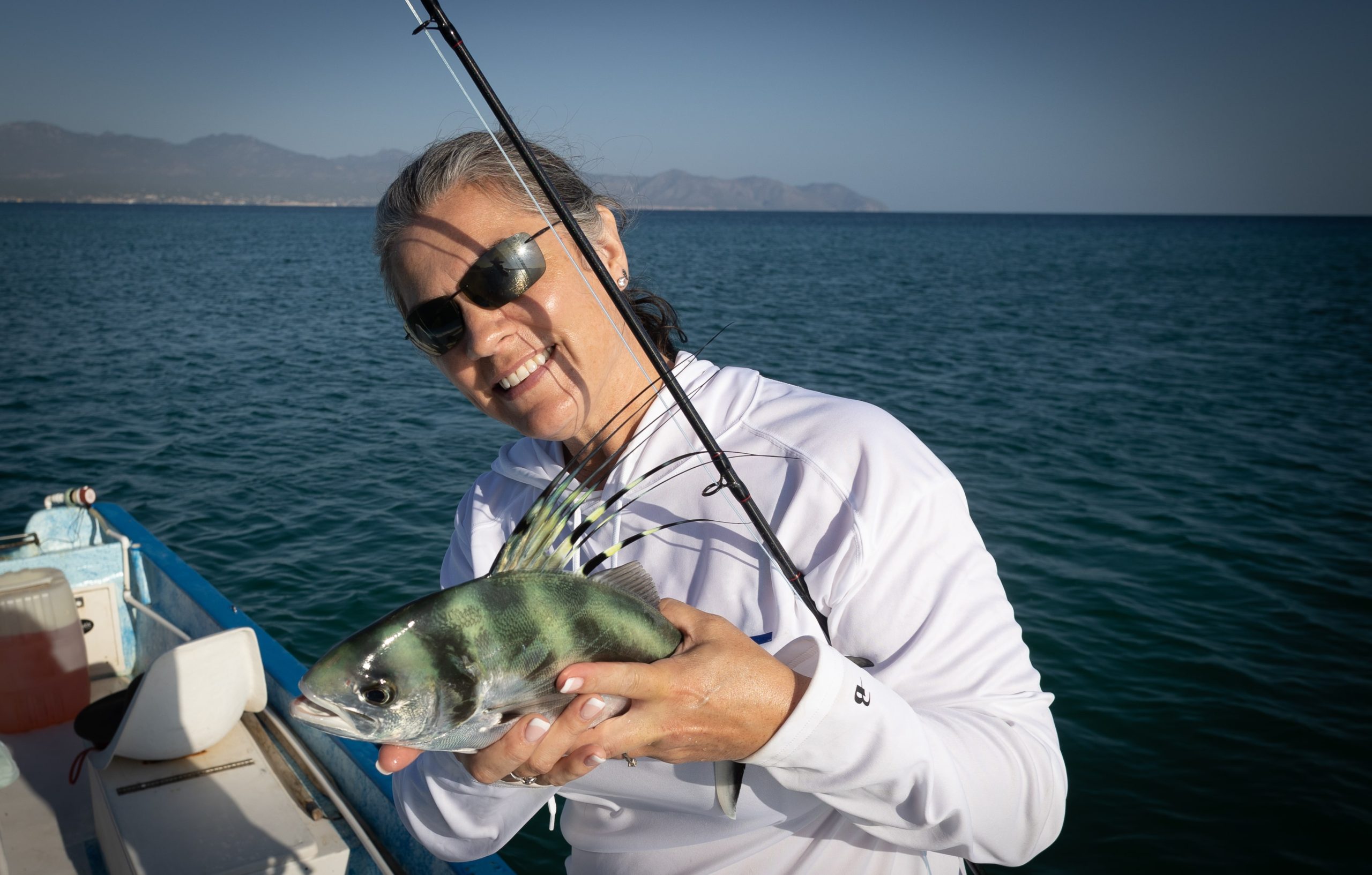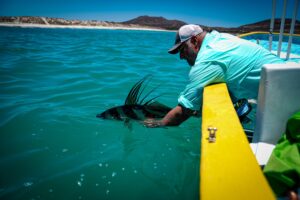No products in the cart.
Return To ShopIs it Safe to Fly Fish for Roosterfish in Baja California?
Ah, the mighty roosterfish of Baja California!
These powerful predators are the stuff of angling legend, inspiring countless anglers to pack their rods and head south for the ultimate sport fishing experience. But is it safe to pursue these finned fighters in the warm waters of Baja? As a seasoned angler and roosterfish enthusiast, I’m here to give you the lowdown on what you need to know before you go “wheels-up” on this adventure.
I would not claim to be an expert in travel safety, but I have never had a security problem while abroad. I am often asked the question: “Is it safe to travel to Baja, California?” Well, my dear reader, the answer is yes…and no. But don’t worry; I’m not going to leave you hanging. In this blog, I’ll give you the lowdown on the safety situation in Baja, California, while sprinkling in some humor and wit along the way.
Let’s start with the good news: Baja California is a beautiful and fascinating destination worth visiting. From the stunning beaches of Cabo San Lucas to the rugged mountains of the Sierra de San Francisco, Baja California has something for everyone. And the people? Some of the friendliest and most welcoming you’ll meet anywhere in the world. But as with any travel destination, you must remember some safety considerations.
One of the biggest safety concerns in Baja California is crime. Like many parts of Mexico, Baja California has experienced its fair share of drug-related violence in recent years. However, it’s important to note that much of this violence is confined to the border region with the United States, particularly in cities like Tijuana and Mexicali. Tourist areas like Cabo San Lucas, La Paz, and Loreto have a much lower incidence of crime, although it’s still important to exercise caution and use common sense when traveling.
So what does that mean in practical terms? Well, for starters, it means avoiding certain parts of Baja California altogether. If you’re flying into the region, it’s best to avoid Tijuana and Mexicali entirely, and instead fly into San José del Cabo or La Paz. If you’re driving, it’s important to be aware of your surroundings and avoid driving at night, especially on isolated roads. Stick to well-traveled routes and don’t take unnecessary risks.
Once you’re in Baja California, there are a few other things to keep in mind. Petty theft is a problem in some areas, particularly in tourist hotspots like Cabo San Lucas. Make sure to keep your valuables secure and be aware of your surroundings at all times. If you’re carrying cash, don’t flaunt it around, and use ATMs located inside banks or other secure locations. And if you’re planning on renting a car, make sure to use a reputable rental company and avoid leaving valuables in the car, as break-ins are not uncommon.
But enough about safety concerns. Let’s talk about the fun stuff! Baja California is a food lover’s paradise, with everything from fresh seafood to mouth-watering tacos to the local specialty of chocolate clams (yes, they’re a real thing). And if you’re a fan of tequila or mezcal, you’re in luck, as Baja California is home to some of the best distilleries in Mexico. Make sure to try some of the local spirits, but remember to drink responsibly (and never drink and drive).
If you’re looking for adventure, Baja California has plenty of options. Take a whale watching tour in the Sea of Cortez, go hiking in the Sierra de San Francisco, or try your hand at surfing in Todos Santos. And of course, there are the beaches—Miles and miles of pristine coastline, with crystal clear water and soft, white sand. Just make sure to swim only in designated areas and pay attention to any warning signs about strong currents or dangerous marine life.
So, is it safe to travel to Baja California? The answer, as with any travel destination, depends on a variety of factors. While there are certainly safety concerns to be aware of, the vast majority of travelers to Baja California have a safe and enjoyable experience. As long as you exercise common sense, avoid high-risk
One of the biggest safety concerns in Baja California is crime. Like many parts of Mexico, Baja California has experienced its fair share of drug-related violence in recent years. However, it’s important to note that much of this violence is confined to the border region with the United States, particularly in cities like Tijuana and Mexicali. Tourist areas like Cabo San Lucas, La Paz, and Loreto have a much lower incidence of crime, although it’s still important to exercise caution and use common sense when traveling.
So what does that mean in practical terms? Well, for starters, it means avoiding certain parts of Baja California altogether. If you’re flying into the region, it’s best to avoid Tijuana and Mexicali entirely, and instead fly into San José del Cabo or La Paz. If you’re driving, it’s important to be aware of your surroundings and avoid driving at night, especially on isolated roads. Stick to well-traveled routes and don’t take unnecessary risks.
Once you’re in Baja California, there are a few other things to keep in mind. Petty theft is a problem in some areas, particularly in tourist hotspots like Cabo San Lucas. Make sure to keep your valuables secure and be aware of your surroundings at all times. If you’re carrying cash, don’t flaunt it around, and use ATMs located inside banks or other secure locations. And if you’re planning on renting a car, make sure to use a reputable rental company and avoid leaving valuables in the car, as break-ins are not uncommon.
But enough about safety concerns. Let’s talk about the fun stuff! Baja California is a food lover’s paradise, with everything from fresh seafood to mouth-watering tacos to the local specialty of chocolate clams (yes, they’re a real thing). And if you’re a fan of tequila or mezcal, you’re in luck, as Baja California is home to some of the best distilleries in Mexico. Make sure to try some of the local spirits, but remember to drink responsibly (and never drink and drive).
If you’re looking for adventure, Baja California has plenty of options. Take a whale watching tour in the Sea of Cortez, go hiking in the Sierra de San Francisco, or try your hand at surfing in Todos Santos. And of course, there are the beaches—Miles and miles of pristine coastline, with crystal clear water and soft, white sand. Just make sure to swim only in designated areas and pay attention to any warning signs about strong currents or dangerous marine life.
So, is it safe to travel to Baja California? The answer, as with any travel destination, depends on a variety of factors. While there are certainly safety concerns to be aware of, the vast majority of travelers to Baja California have a safe and enjoyable experience. As long as you exercise common sense, avoid high risk.
First things first: roosterfish are not to be trifled with. These beasts can grow up to six feet long and weigh over 100 pounds, which means they have the power to seriously ruin your day if you’re not careful. That being said, the good news is that roosterfish are not typically aggressive towards humans, so as long as you give them their space and handle them properly when you catch them, you should be fine.
Of course, the biggest risk when fly fishing for roosterfish in Baja is not the fish themselves, but rather the various hazards that come with fishing in a remote, rugged environment. For starters, the sun in Baja can be brutal, and if you’re not careful, you can easily end up with a nasty sunburn or heat stroke. Make sure to wear plenty of sunscreen, drink lots of water, and take breaks in the shade when you need to.
Another hazard to watch out for is the rocky coastline. Roosterfish love to hang out around rocky points and reefs, which means you’ll need to be able to cast your fly accurately and then maneuver your fish away from any sharp rocks or obstructions. If you’re not used to fishing in this kind of environment, it can be a bit nerve-wracking at first, but with practice, you’ll get the hang of it.
And then there are the other creatures of Baja California to contend with. From stingrays to jellyfish to venomous snakes, there are plenty of things that can give you a nasty bite or sting if you’re not careful. But don’t worry, as long as you keep your eyes peeled and watch where you step, you should be able to avoid most of the hazards.
So, with all that said, is it safe to fly fish for roosterfish in Baja California? The answer, as with most things in life, is “it depends.” If you’re a competent angler with experience fishing in challenging environments, and you take the necessary precautions to stay safe and healthy, then yes, it’s perfectly safe to pursue these magnificent fish. But if you’re a novice angler who’s never fished in saltwater before, or if you’re not comfortable with the idea of navigating a rocky coastline or dealing with the other hazards of Baja, then it might be best to stick to more beginner-friendly waters.
Of course, even if you do everything right and take all the necessary precautions, there’s always the chance that something unexpected could happen. Maybe a big wave knocks you off your feet and drags you out to sea, or maybe you accidentally hook a marlin instead of a roosterfish and end up in a battle you’re not prepared for. But hey, that’s all part of the adventure, right?
In conclusion, fly fishing for roosterfish in Baja California can be an incredible experience, full of excitement, challenge, and beauty. But it’s not something to take lightly. Make sure you’re prepared for the environment, the fish, and the other hazards you may encounter, and always put safety first. And if all goes well, you just might end up with a trophy-sized roosterfish on the end of your line and a story you’ll be telling for years to come. Good luck, and stay salty, amigos!
Donnie Price
El Gallo Fly Fishing Lodge
P.S. If you like our content, and am a fan of what we do, keep a lookout for our upcoming merch. We will have it available soon, so keep an eye out for our online store.
Related posts
Fly Fishing for roosterfish is not an easy endeavor, but it is well worth it, this is why! Continue reading
What would the World of Fly Fishing Look Like if Elon Musk Was a Fly Fisher???!!! I know that he would love roosterfish on the... Continue reading
The full story of our Jungle Tarpon Fly Fishing adventure of 2023 Continue reading
Roosterfish fishing in Baja, California has long been revered as an exhilarating pursuit that tests the skills and patience of anglers. While fly fishing purists... Continue reading
The season is upon us! There are plenty of roosters around, but this last week proved less opportunity than most. Still plenty of fish, and... Continue reading










Leave a reply